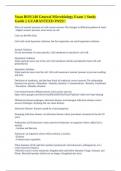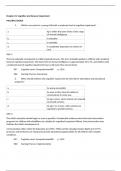Yuan BIOl 240 General Microbiology Exam 1 Study
Guide || GUARANTEED PASS!!
Effect of osmotic pressure on cells correct answers The changes in diffusion gradient of water
-Higher osmotic pressure, more stress on cell
Cells are 80-90% H2O
Cell walls resist hypotonic solutions, but few organisms can resist hypertonic solutions
Isotonic Solution:
No net movement of water particles. Cell membrane is attached to cell wall.
Hypertonic Solution:
Water particles move out of the cell. Cell membrane shrinks and detaches from cell wall
(plasmolysis)
Hypotonic Solution:
Water particles move into the cell. Cell wall counteracts osmotic pressure to prevent swelling
and lysis
Definition of symbiosis, and the three kinds of symbiosis correct answers The relationship
between two species / Mutualism - Benefits, Benefits / Commensalism - Benefits, Unaffected
/ Parasitism - Benefits, Harmed
Conversion between different metric units correct answers
https://drive.google.com/file/d/1yQdMyoHZJIfXizFEae97qJEtoyf-sQin/view?usp=sharing
Difference between pathogen, infectious disease, and emergent infectious disease correct
answers Pathogen: anything that can cause disease.
Infectious Disease: disease caused by a microorganism.
Emerging infectious disease: an infectious disease whose prevalence increased in the last 20
years
Prokaryotes and Eukaryotes correct answers Prokaryote: an organism whose cell(s) lack a
nucleus.
-Archaea and Bacteria
Eukaryote: an organism whose cell(s) contains a nucleus.
-Eukarya
-Contain many organelles
Three domains of life and their qualities (prokaryotic and eukaryotic, pathogenicity, etc.)
correct answers Eukarya:
-Microbes exist in every eukaryotic kingdom (the rank below domain): Fungi, Animals, and
Plants. Microbial protists (which are no longer a kingdom) also exist
,Archaea:
-Prokaryotic, but differ significantly from bacteria in metabolic pathways, molecular
structure, and genetics
-Widespread, and can live in extreme environments
-Not pathogenic to humans
Bacteria:
-Prokaryotic
-Most are harmless or helpful, but some are pathogens, organisms that cause disease in
another organism
-Most have peptidoglycan cell walls, made of proteins and sugars
-Use a variety of energy and carbon sources
Qualities of the protists, fungi, helminths, and viruses correct answers Protist:
-Diverse, genetically distant group
-Vary widely in size, appearance, and habitat
-Includes algae and protozoa
-Algae: mostly aquatic, photosynthetic organisms that possess cellulose in cell walls
-Agar: derived from algae, used in many microbio labs to culture microbes
-Protozoa: diverse group that contains individuals with a variety of adaptations: flagella,
photosynthesis, free-living, parasitism, etc.
-Some are human pathogens
Fungi:
-Not photosynthetic, and cell walls are made of chitin
-Yeast: unicellular fungi that resemble coccus bacteria
-Brewing, vaginal yeast, etc.
-Mold: filamentous fungi that decompose organic matter
-Pharmaceuticals, production of mycotoxins, etc.
Helminths(Parasitic Worms):
-Although observable by eye as adults, eggs and larvae are studied in microbiology
Viruses:
-Acellular: not made of cells
-Not categorized as living to some experts- fits in between living and nonliving
-Genetic instructions (DNA or RNA) in a protein coat
-Requires a cell to act as host for reproduction
Contributions of Hooke, Leeuwenhoek, Redi, Pasteur, Lister, Koch, and Linnaeus correct
answers Robert Hooke (1665): First observation of cells
Anton van
Leeuwenhoek (1673): Performs first experiments on microscopic organisms with aid of
microscope
Loius Pasteur (1861): Pasteur showed that fermented liquids can be heated to kill microbes
without getting so hot as to evaporate the alcohol and invented Pasteurization: Process of
applying high heat to kill microbes that cause spoilage
, Joseph Lister (1865): "Father of Modern Surgery" Used first antiseptic to sterilize surgical
equipment
Robert Koch (1880's): demonstrated with anthrax that disease is caused by a certain organism
Carl Linnaeus (1735): Every organism has one scientific name in Latin (Eshcerichia coli/ E.
coli)
Independent variables, dependent variables, and constants correct answers Independent
variable: the part of the experiment that is being manipulated in order to see its effect on the
dependent variable (e.g. color of light)
-Only one
-The different kinds of manipulations are called conditions
Dependent variable: the part of the experiment that is being measured in order to see what
effect the independent variable has (e.g. growth of potted plants)
-Can be one or more
Constants: parts of the experiment that remain the same between different conditions (e.g.
amount of water, temperature)
Difference between biogenesis and spontaneous generation correct answers Spontaneous
Generation: life comes from nonliving things
Biogenesis: life must come from preexisting life
Experiment to test biogenesis and spontaneous generation correct answers 1 unsealed jar -
resulted in maggots being on meat
1 sealed jar - resulted in no maggots being on meat
cloth covered jar - resulted in maggots on the cloth but not on the meat
https://drive.google.com/file/d/16tdExzC74aVLDnj0g6d1lBav0z5hruR4/view?usp=sharing
Pasteur's sterility experiment correct answers
https://drive.google.com/file/d/1pDg9vFIUlheU2MPj6aCGrr-ynTpp_P5F/view?usp=sharing
Early ideas of disease transmission correct answers Spontaneous Generation: life comes from
nonliving things
Biogenesis: life must come from preexisting life
Miasma: diseases were caused by "bad air"
Germ Theory of Disease, and the info each postulate gives (lecture, but textbook also has
explanation on pg. 679) correct answers
https://drive.google.com/file/d/1ZaPkoiiMEFRzjhi9vVdYkfs6fU6YqNqN/view?usp=sharing





